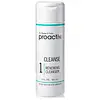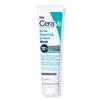What's inside
What's inside
 Key Ingredients
Key Ingredients

 Benefits
Benefits

 Concerns
Concerns

 Ingredients Side-by-side
Ingredients Side-by-side

Benzoyl Peroxide 2.5%
Water
Skin ConditioningMagnesium Aluminum Silicate
AbsorbentGlyceryl Stearate
EmollientPEG-100 Stearate
Sorbitol
HumectantDimethyl Isosorbide
SolventDisodium PEG-12 Dimethicone Sulfosuccinate
CleansingTridecyl Stearate
EmollientNeopentyl Glycol Dicaprylate/Dicaprate
EmollientParaffin
PerfumingCetyl Esters
EmollientAnthemis Nobilis Flower Extract
MaskingTridecyl Trimellitate
EmollientTrisodium Sulfosuccinate
BufferingPEG-12 Dimethicone
Skin ConditioningSodium Sulfate
Sodium Hyaluronate
HumectantPropylene Glycol
HumectantSodium PCA
HumectantXanthan Gum
EmulsifyingPhenoxyethanol
PreservativeImidazolidinyl Urea
PreservativeMethylparaben
PreservativePropylparaben
PreservativeParfum
MaskingBenzoyl Peroxide 2.5%, Water, Magnesium Aluminum Silicate, Glyceryl Stearate, PEG-100 Stearate, Sorbitol, Dimethyl Isosorbide, Disodium PEG-12 Dimethicone Sulfosuccinate, Tridecyl Stearate, Neopentyl Glycol Dicaprylate/Dicaprate, Paraffin, Cetyl Esters, Anthemis Nobilis Flower Extract, Tridecyl Trimellitate, Trisodium Sulfosuccinate, PEG-12 Dimethicone, Sodium Sulfate, Sodium Hyaluronate, Propylene Glycol, Sodium PCA, Xanthan Gum, Phenoxyethanol, Imidazolidinyl Urea, Methylparaben, Propylparaben, Parfum
Benzoyl Peroxide 10%
Water
Skin ConditioningGlycerin
HumectantPropylene Glycol
HumectantCocamidopropyl Hydroxysultaine
CleansingSodium C14-16 Olefin Sulfonate
CleansingPotassium Hydroxide
BufferingCeramide NP
Skin ConditioningCeramide AP
Skin ConditioningCeramide EOP
Skin ConditioningCarbomer
Emulsion StabilisingNiacinamide
SmoothingGlycolic Acid
BufferingTrideceth-6
EmulsifyingTriethyl Citrate
MaskingSodium Citrate
BufferingSodium Hyaluronate
HumectantSodium Hydroxide
BufferingSodium Lauroyl Lactylate
EmulsifyingCholesterol
EmollientPropanediol
SolventTetrasodium EDTA
Caprylyl Glycol
EmollientDiethylhexyl Sodium Sulfosuccinate
CleansingPhytosphingosine
Skin ConditioningXanthan Gum
EmulsifyingAcrylates/C10-30 Alkyl Acrylate Crosspolymer
Emulsion StabilisingBenzoic Acid
MaskingPEG-30 Dipolyhydroxystearate
EmulsifyingBenzoyl Peroxide 10%, Water, Glycerin, Propylene Glycol, Cocamidopropyl Hydroxysultaine, Sodium C14-16 Olefin Sulfonate, Potassium Hydroxide, Ceramide NP, Ceramide AP, Ceramide EOP, Carbomer, Niacinamide, Glycolic Acid, Trideceth-6, Triethyl Citrate, Sodium Citrate, Sodium Hyaluronate, Sodium Hydroxide, Sodium Lauroyl Lactylate, Cholesterol, Propanediol, Tetrasodium EDTA, Caprylyl Glycol, Diethylhexyl Sodium Sulfosuccinate, Phytosphingosine, Xanthan Gum, Acrylates/C10-30 Alkyl Acrylate Crosspolymer, Benzoic Acid, PEG-30 Dipolyhydroxystearate
 Reviews
Reviews

Ingredients Explained
These ingredients are found in both products.
Ingredients higher up in an ingredient list are typically present in a larger amount.
Benzoyl Peroxide is famous for fighting acne. This is because it does a variety of tasks on the skin: it helps reduce excess oil, kill bacteria, and clear out dead skin cells. In other words, it is effective at unclogging pores.
These properties make it great at fighting different types of acne, including cystic and inflammatory types of acne.
When targeting the bacteria in your pores, Benzoyl Peroxide has been shown to kill the bacteria without causing sensitivity. It also helps keep your skin's natural bacteria and biome balanced. Having a healthy biome protects your skin from external harmful factors.
Once Benzoyl Peroxide is absorbed into the skin, our bodies turn it into benzoic acid and quickly exits in urine.
When using Benzoyl Peroxide, it may be irritating for some people due to a variety of reasons, such as a broken skin barrier or just an allergic reaction. We recommend speaking with a professional about using this ingredient if you have concerns.
Learn more about Benzoyl PeroxidePropylene Glycol is an odorless, colorless liquid. As a humectant, it helps skin retain moisture. It also aids in delivering active ingredients.
Another role of this ingredient is preventing a product from melting or freezing. Propylene glycol also adds antimicrobrial properties to a product, elongating product lifespan.
This ingredient is considered an organic alcohol and commonly added into both cosmetics and foods.
Those with sensitive skin or conditions may develop a rash when using this ingredient.
Learn more about Propylene GlycolSodium Hyaluronate is hyaluronic acid's salt form. It is commonly derived from the sodium salt of hyaluronic acid.
Like hyaluronic acid, it is great at holding water and acts as a humectant. This makes it a great skin hydrating ingredient.
Sodium Hyaluronate is naturally occurring in our bodies and is mostly found in eye fluid and joints.
These are some other common types of Hyaluronic Acid:
Learn more about Sodium HyaluronateWater. It's the most common cosmetic ingredient of all. You'll usually see it at the top of ingredient lists, meaning that it makes up the largest part of the product.
So why is it so popular? Water most often acts as a solvent - this means that it helps dissolve other ingredients into the formulation.
You'll also recognize water as that liquid we all need to stay alive. If you see this, drink a glass of water. Stay hydrated!
Learn more about WaterXanthan gum is used as a stabilizer and thickener within cosmetic products. It helps give products a sticky, thick feeling - preventing them from being too runny.
On the technical side of things, xanthan gum is a polysaccharide - a combination consisting of multiple sugar molecules bonded together.
Xanthan gum is a pretty common and great ingredient. It is a natural, non-toxic, non-irritating ingredient that is also commonly used in food products.
Learn more about Xanthan Gum